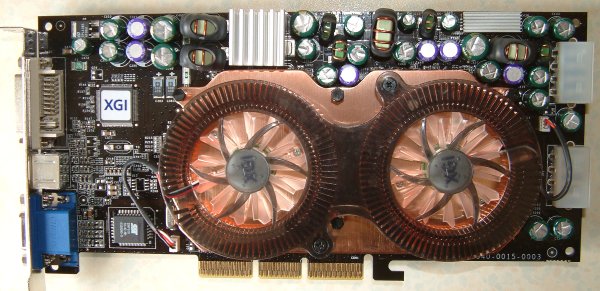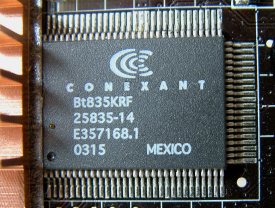Appearance and technical musings
XGI's not a name many of us are familiar with. Time to fill in a few historical gaps. XGI's actually the end result of SiS (Silicon Integrated Systems) and Trident's know how. That's not as surprising as it first sounds, as both companies were leading players in the mid-1990s. SiS, under the Xabre name, recently launched a series of low- and mid-range cards that provided initial promise. Driver problems and certain hardware deficiencies stopped them, in most peoples' eyes, from truly challenging DX9 parts from you know who.XGI pools together considerable industry talent and hopes that the introduction of the XGI brand will yield better results than SiS' efforts. We're casting our eye over XGI's premier card, the Volari Duo. We'll take a physical look first and commentate with a brief technological appraisal. It certainly sounds interesting on paper.

A funky cooler with two GPU fans isn't just an aesthetic measure. As the very name of the card contends, this is a dual-chip configuration, much like 3Dfx's doomed Voodoo series. ATI and NVIDIA have both shunned this approach to increasing performance for a number of reasons. Inherent difficulties in producing a top-end dual-chip card include, amongst other things, ensuring sufficient memory bandwidth for both, chip-connecting bottleneck, and cost. As you can clearly see, the Volari Duo V8 Ultra takes up a significant amount of PCB space.
Technologically-speaking, the Volari Duo V8 is an up-to-date design. Each chip contains 8 rendering pipelines that make it into a 16-pipe design. That's GeForce6 and Radeon X800 XT country, folks. Add in the 350MHz clock speed and you have a potential fillrate of 5.6GPixels/s. Compare that with the Radeon 9800 XT's 3.296GTexel/s. 2 chips dictate a dual 128bit memory controller. To that end, XGI uses 900MHz-rated DDRII modules. Another quick calculation reveals potential bandwidth of 28.8GB/s. Potential is the key word in the last two sentences. Hitting the maximum limit is difficult for a first-time design.
It's not all about sheer grunt. XGI's Volari Duo V8 Ultra is a full DirectX 9.0 GPU. There's support for Pixel Shader 2.0, with each GPU carrying 4 pixel shader units. Similarly, there's 2 vertex shaders on each chip, making 4 in total. FSAA and anisotropic filtering both top out at 4X. It all sounds simple on paper, but how have XGI surmounted the problems of running 2 chips on one board?. XGI terms this enabling technology as BitFluent.
Specification reveal that the first GPU (on the left) is connected directly to an AGP 8x interface. That's the norm for today's cards, PCI-E's reserved for the next iteration of cards from ATI and NVIDIA. What XGI has done, effectively, is to construct another similar bridge between GPUs. XGI's BitFluent bridge uses a 32-bit bus that offers a maximum throughput of 2.13GB/s. Sounds similar to AGP, doesn't it. This picture highlights BitFluent's AGP-like features. Both GPUs work in a parallel nature, that is, one doesn't have to wait for the other to finish rendering. Therefore two command queues must be kept for each chip, and each GPU is fed by an 128-bit memory controller and has its own frame buffer. Dual GPUs make sense if implemented correctly; the problem has always been one of efficiency. It's intrinsically difficult to attain the same kind of efficiency from a 2-chip design as opposed to the traditional single-chip architecture. That's why ATI and NVIDIA have shied away from it.

Another massive hunk of copper hides the 900MHz-rated DDRII modules that total 256MB, split 128MB over each GPU. The relative size of the AGP slot gives you some idea of the card's overall size. Fitting 2 GPUs on to a single card is a space-consuming affair. We had no problems in installing the card into a regular Lian Li PC-60 case; it's about the same length as NVIDIA's GeForce6 line, and just a bit longer than a present FX 5950 Ultra.

Conexant's VIVO chip makes this more than just a brute, top-end card. Indeed, XGI is keen to point out that it's not all out balls-out power. The Volari Duo V8 Ultra features a Cypher Video Processor which uses an advanced pixel-based deinterlacing algorithm. Sounds much like ATI's VIDEOSHADER technology.

Nothing unusual to see here. DVI, S-Video and HD15.

Back around to the front of the Volari Duo. A nod towards the SiS heritage. The '301MV chip, in this instance, is responsible for TV-Out support.

Two 0.15-micron-based GPUs running at 350MHz each demand a Molex connector apiece. The close cramming of all power components means that no PCB space is wasted. It's a big card, sure, but that's just a side-effect of situating two GPUs on to a single card. We had no problems in running the test card with a 420w Samcheer PSU. The system also included an Athlon 64 Model 3400+, 512MB RAM, 2 optical drives and a large hard drive.
XGI, with the Volari Duo V8 Ultra, takes an interesting approach into designing a power card. Parallelism, as used here, is prone to not achieving the kind of real-world efficiency we're used to with single-chip designs. XGI will have to overcome this if the V8 Ultra is to realise its considerable potential.









